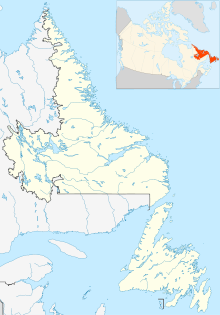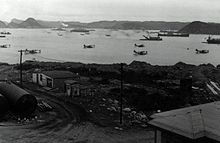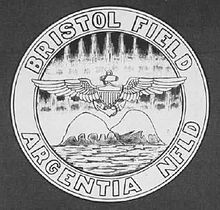- Naval Station Argentia
-
Naval Air Station Argentia 
IATA: none – ICAO: none Summary Airport type Military Operator United States Navy Location Argentia, Newfoundland Elevation AMSL 28 ft / 9 m Coordinates 47°18′22″N 053°59′24″W / 47.30611°N 53.99°WCoordinates: 47°18′22″N 053°59′24″W / 47.30611°N 53.99°W Map Location in Newfoundland and Labrador Runways Direction Length Surface ft m 04/22 (Closed) 7,400 2,250 Asphalt concrete 14/32 (Closed) 5,000 1,525 Asphalt concrete 08/26 (Closed) 5,100 1,550 Asphalt concrete Naval Station Argentia is a former base of the United States Navy that operated from 1941-1994. It was established in the community of Argentia in what was then the Dominion of Newfoundland, which later became the tenth Canadian province (see Newfoundland and Labrador).
Contents
Construction
Established under the British-U.S. lend-lease program, the base was first occupied on January 25, 1941 following the expropriation of the flat headland formed by a small natural bay called Little Placentia Sound and the western end facing Placentia Bay by the Newfoundland government; over 400 families were displaced.
Construction crews rushed to build the base as well as an adjoining air field. On July 15, 1941, the Naval Operating Base was commissioned.
Atlantic Conference
On August 7, 1941 the heavy cruiser USS Augusta carrying U.S. President Franklin D. Roosevelt arrived in the anchorage at Little Placentia Bay off the base. Roosevelt inspected the base construction progress and did some fishing from Augusta over the next two days. Augusta was joined by the British warship HMS Prince of Wales carrying British Prime Minister Winston Churchill on August 9, 1941. While in the Argentia anchorage from August 9–12, the chiefs of staff of Britain and the U.S. met to discuss war strategies and logistics once the U.S. joined in the war. The two leaders and their aides also negotiated the wording of a press release that they called a "joint statement". That press release was issued on August 14, 1941 in Washington, D.C. and was issued simultaneously in London, England. Several days later the Daily Herald (a London newspaper) would characterize the public statement as being the Atlantic Charter. However, there never was a signed, legal document called the "Atlantic Charter". Neither Roosevelt nor Churchill signed it. The conference concluded the evening of August 12, 1941 with the British and American warships and their escorts passing in review before departing the area for their home ports. The "joint declaration" was publicly announced on August 14, presumably after Prince of Wales had returned to UK waters.
World War II operations
On August 28, 1941 Naval Air Station Argentia was commissioned. NAS Argentia was built on the plateau atop the triangular peninsula adjacent to Naval Station Argentia's anchorage and shore facilities. The air station was used to base convoy protection, coastal patrol and anti-submarine aircraft, both land-based aircraft and seaplanes. While NAS Argentia was nominally an independent facility from Naval Station Argentia, both facilities are largely viewed as one.
Beginning that summer, USS Prairie was used to house Flag Headquarters at the base.
February, 1942 saw the Argentia base at the centre of one of the worst disasters in the US Navy's history when USS Pollux and USS Truxtun were wrecked 75 miles southwest of the base. Over 100 victims were buried in Argentia's military cemetery.
In March 1942 the United States Army established Fort McAndrew at Argentia to provide security to the navy base through an anti-aircraft battery. Later that spring the Royal Navy established a small maintenance base at Argentia to service its ships involved in convoy escort groups operating out of Halifax, Sydney, St. John's and in the Gulf of St. Lawrence.
In the spring of 1943 a 7,000 ton floating drydock was installed at Argentia, along with a ship repair facility. In August 1943, CTF-24 Flag Headquarters moved ashore to permanent facilities after having been housed aboard USS Prairie.
In 1944, Argentia served as one of the two stopover bases for the refueling, maintenance, and crew changes of the six United States Navy (USN) K-ships (blimps) that made the first transatlantic crossings of non-rigid airships. Blimps K-123 and K-130 from USN Blimp Squadron 14 (also known as ZP-14, Blimpron 14, or "The Africa Squadron") left South Weymouth Naval Air Station in Massachusetts on May 28, 1944 and landed at Argentia about 16 hours later. The two K-ships then flew for approximately 22 hours to Lagens Field on Terceira Island in the Azores, the second stopover base for the transatlantic flights. The last leg was a ~20 hour flight to the squadron's final destination with Fleet Air Wing (FAW) 15 at Port Lyautey, French Morocco (now Kenitra, Morocco). Blimps K-123 & K-130 were followed by K-109 & K-134 and K-112 & K-101 which left South Weymouth on June 11 and 27, respectively, in 1944.[1] These six blimps initially conducted nighttime anti-submarine warfare operations to complement the daytime missions flown by FAW-15 aircraft (PBYs and B-24s) using magnetic anomaly detection to locate U-boats in the relatively shallow waters around the Straits of Gibraltar. Later, ZP-14 K-ships conducted minespotting and minesweeping operations in key Mediterranean ports and various escort missions including that of the convoy carrying Franklin Roosevelt and Winston Churchill to the Yalta Conference in early 1945. In late April 1945, K-89 and K-114 left Weeksville NAS in North Carolina and flew a southern route to NAS Bermuda, the Azores, and Port Lyautey where they arrived on May 1, 1945.[2][3]
Cold War operations
Following the war in August 1945, the first dependents of naval personnel were permitted to move to Argentia to live in permanent quarters on base.
In 1946, Fort McAndrew was transferred to the U.S. Army Air Forces which became the United States Air Force in 1947. In 1948, Fort McAndrew was renamed McAndrew AFB.
In 1949, Newfoundland joined Canadian Confederation as the 10th province. During the Cold War, Argentia Naval Station became a key "node" in the Northwest Atlantic's SOSUS network, helping to detect Soviet nuclear submarines. The base was the target of several espionage attempts between the 1940s–1990s as a result.
In 1955 McAndrew AFB was decommissioned and the facility was turned over the US Navy with USAF personnel moving to other locations in Newfoundland such as Ernest Harmon AFB, Goose AFB or various radar installations being built in conjunction with the Royal Canadian Air Force such as the Pinetree Line, Mid-Canada Line and DEW Line. Radar picket ships such as the USS Hissem used the base.
In 1973, Naval Air Station Argentia was decommissioned and the land transferred in 1975 to the Government of Canada. It was subsequently transferred to the provincial government for development.
Until 1994, the runways of the former airfield were utilized by the Royal Canadian Air Cadets. The Air Cadets operated weekend glider familiarization through the Air Cadet Gliding Program. The Schweizer SGS 2-33 was launched using an auto-tow launch method, utilizing the entire length of the runway surfaces. Personnel were housed at the Naval Station Argentia facilities. After the US Naval Station was decommissioned, the glider program was operated without facilities support for a few years until the airfield was occupied for the Hydromet Test Facility owned by INCO. With the announcement that the INCO development would not be using the airfield, the Air Cadet Gliding Program once again started using the airfield for gliding operations in May, 2008.
In 1994 the US Navy left Argentia completely when Naval Station Argentia was decommissioned and the last personnel moved out.
Citations
- ^ Blimp Squadron 14
- ^ Kline, R. C. and Kubarych, S. J., Blimpron 14 Overseas, 1944, Naval Historical Center, Navy Yard, Washington, D. C.
- ^ Kaiser, Don, K-Ships Across the Atlantic, Naval Aviation News, Vol. 93(2), 2011.
External links
Categories:- United States Navy bases
- History of Newfoundland and Labrador
- Defunct airports in Newfoundland and Labrador
Wikimedia Foundation. 2010.






